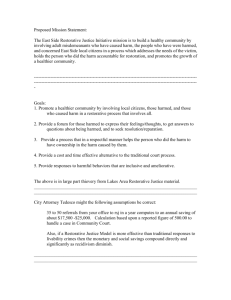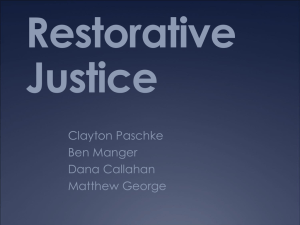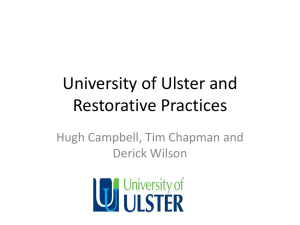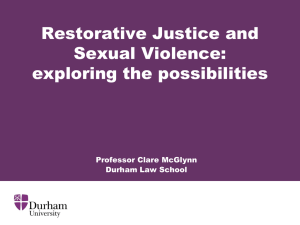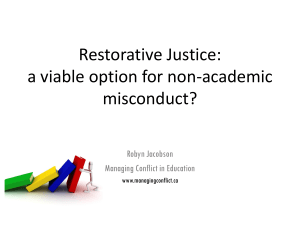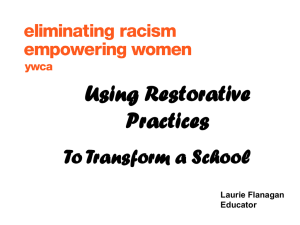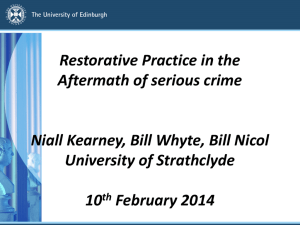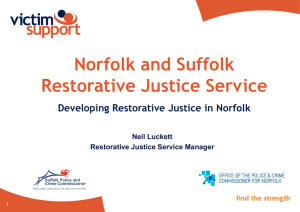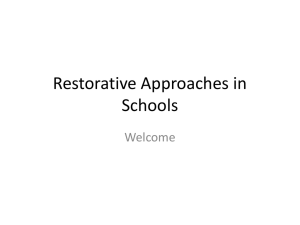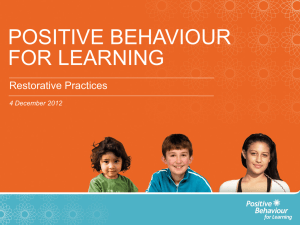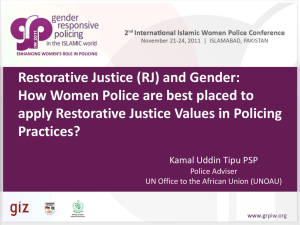The Northern Irish Model of Restorative Justice
advertisement
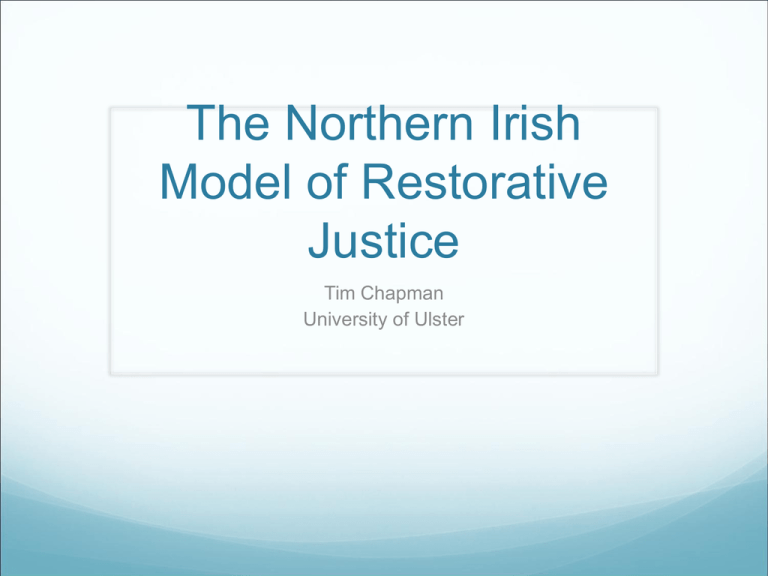
The Northern Irish Model of Restorative Justice Tim Chapman University of Ulster Northern Ireland and Restorative Justice Community system State system Community restorative Low risk – Police restorative justice Ireland Alternatives NI School system Children’s Services Family Group Conferences Children’s Units cautioning Medium risk – Public Prosecution Service referral for diversionary conference by Youth Conference Service High risk – Youth Court referrals to Youth Conference Service Priority young offenders programme Prison Service – rehabilitation and resettlement Youth Conferences Statutory since 2003 Mainstream Prosecution referred Youth court referred No cherry picking Referrals and ratification by PPS or Youth Court The Balanced Model Community Community safety and reintegration Harm Person responsible for harm Reducing risk and working towards a better life Injured party Accountability, protection and repairing the harm Core Values Responsibility Relationship Respect Models of addressing challenging behaviour and its aftermath High Do to Out of anger Be punitive Stigmatising Coercive Punitive Do with Respect Be restorative Inclusive Participative Transformative Responsibility Move away from Out of fear Be neglectful Indifferent Passive Avoidance Low Do for Out of sympathy Be permissive Protective Interventionist Rescuing Relationship High Adapted form McCold and Wachtel’s Social Discipline Window The Youth Conference Process Pre-Conference Conference Post Conference The Dialogue Approach Storytelling Expression of emotion Dialogue on needs and action Measuring Effectiveness Over 9,000 Referrals Year Court PPS Total 2006/07 793 503 1,296 2007/08 1,129 802 1,931 2008/09 792 844 1,636 2009/10 891 949 1,840 2010/11 YTD* Total *2010/11 Apr - Dec 753 777 1,530 4,358 3,875 8,233 *February 2011 Increasing proportion of disposals, reducing custody, reducing reoffending 2006 2005 Baseline Disposal No. ReOffending Total % No. ReOffending Total % Immediate Custody 29 41 70.7 43 59 72.9 Combination Order 6 9 - 7 16 - Community Service Order 15 30 - 18 54 33.3 Probation Order 51 87 58.6 63 127 49.6 Attendance Centre Order 45 97 46.4 53 104 51.0 Community Responsibility Order 21 42 50.0 12 22 - Community based disposals 138 265 52.1 153 323 47.4 Court Ordered Youth Conference 102 215 47.4 43 97 44.3 Div. Youth Conference Plan 63 223 28.3 23 75 30.7 All non-custodial disposals 452 1,110 40.7 409 1,091 37.5 ALL DISPOSALS 481 1,151 41.8 452 1,150 39.3 Outcomes for Youth Conferences Number of youth conferences 9,000 + Over 50,000 people have participated in a youth conference Victim attendance; around 70% Victim and young person satisfaction ; 90% and 95% 8 out of 10 victims prefer the youth conference to the traditional court process 100% victims would recommend conferences to others 94% successful completion of plans England and Wales put three times as many young people into custody as Northern Ireland Success Factors Consistent practice Robust research based practice model Practice manual Performance targets Supervision Commitment to professional development Accredited training Supporting the increasing demands of practice Courses Three modules Undergraduate certificate Postgraduate Certificate Six modules Postgraduate certificate Postgraduate diploma Nine modules or dissertation Masters Students Open Course 23 students Youth Conference Service 48 students Police Service 80 + students Community Restorative Justice 38 students Prison Service 38 Students Youth Justice Agency 66 Students Priority Young Offenders Programme 30 Students Family Group Conferences 40 Students University Modules Foundation skills Reflecting on Restorative Practice Responding restoratively to people who have been harmed Responding restoratively to people responsible for harm Restorative responses to sexual harm Restorative responses to serious and persistent harmful behaviour The restorative prison The restorative school Enhancing restorative skills The restorative community Family group conference practice The restorative organisation and processes Building a restorative society The restorative children’s home Restorative practices and faith organisations Effective Practice External evaluation Performance targets Continuous improvement Building Blocks Innovative Practice Effective Practice Competent Practice Consistent Practice Challenges Ahead YCS Referrals By Young Person No. of Referrals No. young % of young Cumulative % of people people young people 1 2,831 63.1 63.1 2 748 16.7 79.8 3 315 7.0 86.8 4 212 4.7 91.5 5 107 2.4 93.9 6 80 1.8 95.7 7 51 1.1 96.9 8 38 0.8 97.7 9 32 0.7 98.4 10 20 0.4 98.9 11-30 51 1.1 100.0 Total Referrals 8,995 - - No. young people 4,485 - - Priority Youth Offenders Project Intensive relationship Circle of Support and Accountability Other challenges Updating practice > revise practice manual Rebalancing the state and community programmes Prison reform Thank you Contact tj.chapman@ulster.ac.uk
